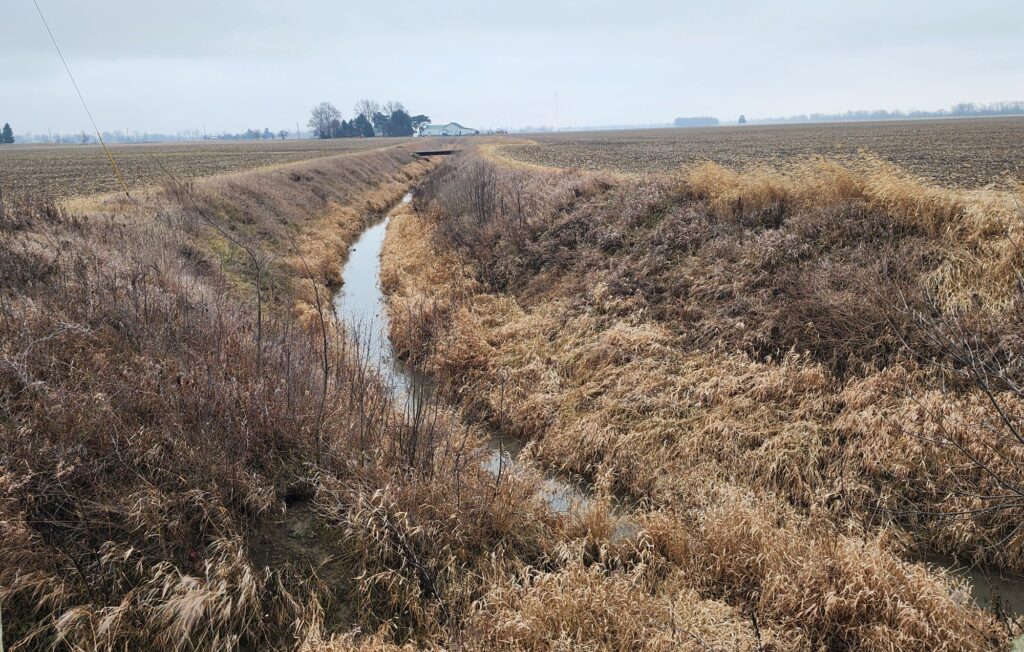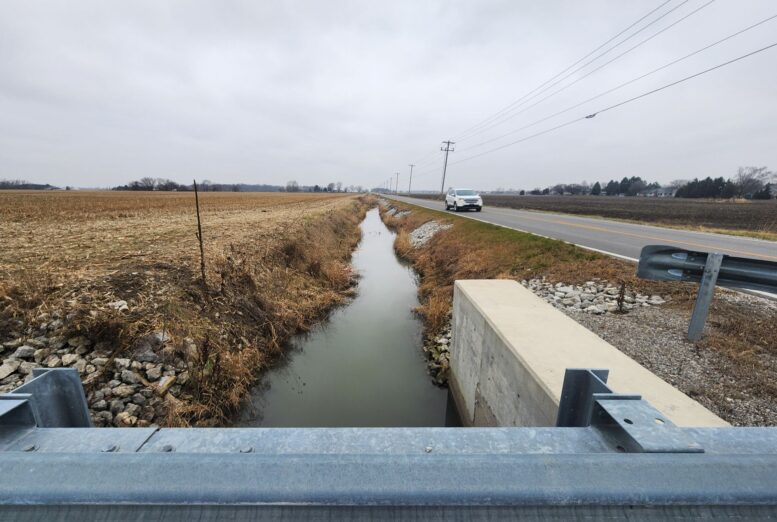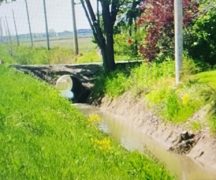By JAN LARSON McLAUGHLIN
BG Independent News
Holmes County is dotted with picturesque Amish farms. Hocking County is dissected by dramatic cliffs and gorges.
And Wood County? Well, it’s striped with deep ditches – not exactly a tourist attraction but a distinction nonetheless.
Wood County ranks at the top of Ohio’s 88 counties, with more than 3,000 miles of ditches.
“We have more miles of ditches than roads,” said Duane Abke, drainage construction coordinator with the Wood County Engineer’s Office.
Officials in other counties just don’t understand the need for so many ditches, said Wood County Engineer John Musteric. Of course, in their regions the water flows downhill – a feature sorely lacking in this county.
“We live in the old Black Swamp, so it wants to be that way,” Abke said.
“If we don’t maintain it, it will be the swamp again,” said Jim Carter, ditch technician with the Wood Soil and Water Conservation District.
The vast majority of farm fields in the county are tiled, sending extra water into ditches. But those ditches, which typically have such small graded slopes, tend to move slowly. The water and wind often erode the soil, taking it into the ditch, where it sits collecting silt, creating jogjams and sometimes allowing trees to grow along the bottoms and sides.
Ditches also get clogged with trash, like old tires being tossed in along with grass clippings and branches. If the flow is slowed enough, full ditches can render field tiles useless, allowing water to spill over into farm fields, and flood developed areas.
Many miles of ditches call for many bridges and culverts over the waterways. But those also can present problems in cases where they are positioned too high and prevent flow, are too small and impede water, or in cases where crumbing concrete creates dams in ditches.

Maintaining the steady flow of ditches may seem a sensible goal. A no-brainer even. But don’t tell that to Musteric, Abke or Carter, who have seen rooms full of landowners erupt in anger over proposals to clean out ditches.
Ditch maintenance hearings are the most contentious meetings held by the county. Such was a recent hearing involving a ditch in Perrysburg Township, which local farmers had petitioned to be maintained by the county. While the farmers wanted the ditch to be unclogged, the residents of a housing development wanted to preserve the trees along the waterway.
It’s all a matter of perspective, with the farmers referring to the waterway as a “ditch,” and the homeowners referring to it as a “river ravine.” It was noted during the public hearing, that the developer of the subdivision marketed the lots to future homeowners as being along a “river ravine.”
Farmers can’t survive in Wood County without knowing how to drain the swamp out of their fields, Carter said.
“They understand drainage,” he said. “The people who live in subdivisions don’t.”
However, frequent flooding takes a toll not only on crops, but also on the landscapes and structures of homes – it just takes more time to see the damage.
But a ditch cleanout is not a pretty project when complete. Farmers may find beauty in their fields draining properly, but homeowners tend to dislike the loss of trees that reveal their “creek” is nothing more than a “ditch.”
Trees must be taken down along ditches during maintenance projects to allow for large equipment to access the bottoms, Musteric said. And for best results, the entire length of a ditch must be cleaned to prevent more flooding once the cleared ditches run into untouched logjams.
“You’ve got to do the whole thing, or you’re not going to do it right,” Musteric said.
To get the county engineer’s office to clean out a ditch, the neighboring landowners have to petition the county commissioners. The commissioners hold hearings on each request.
Those approved for cleaning are put under the county ditch maintenance program. Currently, approximately 680 miles of ditches are in the program, with more being added each year.
“Ultimately it’s the landowners’ responsibility,” Able said. So when the county hires contractors to clean ditches, the property owners along the ditch are assessed for the costs. In some cases, that could include landowners miles away from the ditches, whose property lies in the watershed, Able said.
Once a section of ditch is put under the county maintenance program, it remains there. In more recent years, cleaned out ditches have been sprayed regularly to keep the brush down, Musteric said.
Some landowners wanting to avoid the assessment for ditch work have told the county engineer’s office that they will do the work themselves. But inevitably, the work is too much for landowners to tackle alone, Carter said.
It’s a back-breaking job that can’t be done with simple shovels, saws and buckets. In order to keep water moving, some ditches start out 12- to 13-feet deep in order to provide enough of a grade so the water doesn’t just sit. The Mitchell Road ditch, west of Bowling Green, is an example of such a gaping ditch not seen in other counties in Ohio.

The county’s ditch experts marvel at the deep ditches that were constructed more than a century ago, using mules and rudimentary equipment. Particularly astounding was the building of the Jackson Cutoff, which runs much of the north–south length of the western side of Wood County.
That ditch was dug in the 1850s, by landowners wanting to drain the swamp, and fearful of all the water making its way to Lake Erie, filling rivers or ditches as the waterways snaked their ways across the county. To keep drainage from the southwest from flooding their fields, they dug the Jackson Cutoff.
“They were ahead of their time,” Musteric said.
And now, 170 years later, Wood County is still working to keep the swamp at bay.





